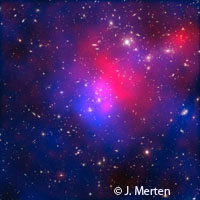Astronomers piece together cosmic crash puzzle
Cosmic crashes pique the interest of astronomers and laypersons alike. So much information is generated when galaxy clusters crash. An international research team has shed new light on the history of a cosmic crash - Abell 2744 - that emerged millions of years ago. The study, funded in part by the DARKMATTERDARKENERGY ('Understanding the dark universe with 3D (three-dimensional) weak gravitational lensing') project, which has clinched a EUR 100,000 Marie Curie Actions: 'International Reintegration Grant' under the EU's Seventh Framework Programme (FP7), helps elucidate the influence of structures on the formation of the universe. The findings are presented in the journal Monthly Notices of the Royal Astronomical Society. 'Like a crash investigator piecing together the cause of an accident, we can use observations of these cosmic pile-ups to reconstruct events that happened over a period of hundreds of millions of years,' explains lead author Dr Julian Merten from the Institute of Theoretical Astrophysics at the University of Heidelberg in Germany. 'This can reveal how structures form in the universe, and how different types of matter interact with each other when they are smashed together.' Co-author Dr Renato Dupke, a visiting research assistant at the Department of Astronomy at the University of Michigan in the United States, says the team dubbed the crash 'Pandora's Cluster' because the collision unleashed many varied and odd phenomena. 'Some of these phenomena had never been seen before,' he adds. Investigations into Abell 2744 have intensified over the years; astronomers have combined data generated from the NASA/ESA (European Space Agency) Hubble Space Telescope, the European Southern Observatory's (ESO) Very Large Telescope (VLT), the Japanese Subaru telescope and NASA's Chandra X-ray Observatory to carry out these studies. The cluster's galaxies are visible in both the Hubble and VLT images. According to the researchers, galaxies may be bright but they account for less than 5 % of the mass. The rest is dark matter (around 75 %), which is invisible, and gas (20 %), whose heat is so strong that it shines only in X-rays. In order to shed light on what transpires with collisions, the researchers mapped the positions of all matter types in Abell 2744. Dark matter is mysterious because it does not emit, absorb or reflect light; it becomes apparent through its gravitational attraction. The team members used gravitational lensing, which is the bending of light rays from distant galaxies as they pass through the gravitational field found in the cluster. They explain that the outcome is a series of informative distortions in the images of galaxies in the background of the Hubble and VLT observations. Scientists could map where the mass, and thus dark matter, lies accurately thanks to the careful plotting of the way the images are distorted. They also say that finding the hot gas in the cluster is not a complex process since the Chandra X-ray Observatory sees it directly without any fuss. These observations, the team says, are important both for determining where the gas is but also for revealing the angles and speeds at which various components of the cluster came together. Their findings brought a number of features to the surface. 'Abell 2744 seems to have formed from 4 different clusters involved in a series of collisions over a period of some 350 million years,' explains author Dan Coe of the Space Telescope Science Institute in the United States. 'The complicated and uneven distribution of the different types of matter is extremely unusual and fascinating.' The team suggests that the complex collision separated out some hot gas and dark matter, resulting in them lying apart from each other and from the visible galaxies. Astronomers from Brazil, Israel, Italy, Taiwan, the United Kingdom and the United States contributed to this study.For more information, please visit:Monthly Notices of the Royal Astronomical Society:http://www.wiley.com/bw/journal.asp?ref=0035-8711Institute of Theoretical Astrophysics at the University of Heidelberg:http://www.ita.uni-heidelberg.de/ita-index_e.shtml?lang=enMarie Curie Actions:http://cordis.europa.eu/fp7/mariecurieactions/home_en.html
Countries
Brazil, Germany, Israel, Italy, Taiwan, United Kingdom, United States



